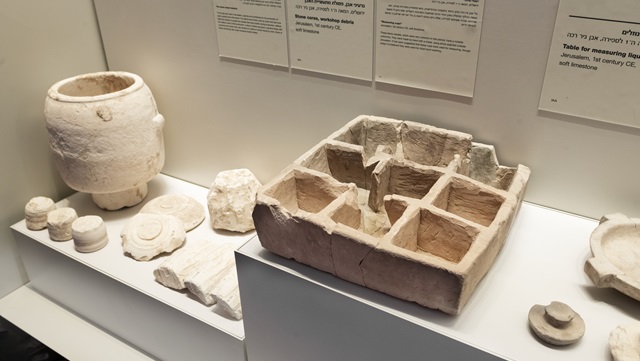
Archaeologists Ari Levy and Rikki Zalut Har-Tuv of the Israel Antiquities Authority at the Pilgrimage Road (Photo by Emil Aladjem, Israel Antiquities Authority)
New archeological evidence of the destruction of Jerusalem by the Romans 2,000 years ago has been found with the discovery of a “rare enigmatic” stone box from the Second Temple period. The box, which is now available for public view for the first time at the Israel Museum, Jerusalem, was discovered during Israel Antiquities Authority excavations in the City of David in Jerusalem.
The square box measuring 30 x 30 cm, was carved from soft limestone and divided inside into nine equal-sized compartments. The multi-compartment container was discovered in a destruction layer inside an ancient store dated to the end of the Second Temple period that once stood alongside the Pilgrimage Road in the City of David. The sides of the box are blacked, indicating that it was burnt perhaps during events of the Great Jewish Revolt, which ultimately led to the destruction of Jerusalem.
This is yet another historic discovery made in Israel. Earlier this week, archeologists from the Israel Antiquities Authority (IAA) revealed that remains of the 1,800-year-old Roman VIth ‘Ferrata’ Iron Legion military base were found in a recent excavation it carried out at the foot of Tel Megiddo (near Haifa), close to the ancient Kfar Othnay village (Greek: Capercotnai).
Will you offer us a hand? Every gift, regardless of size, fuels our future.
Your critical contribution enables us to maintain our independence from shareholders or wealthy owners, allowing us to keep up reporting without bias. It means we can continue to make Jewish Business News available to everyone.
You can support us for as little as $1 via PayPal at office@jewishbusinessnews.com.
Thank you.

The box on display at the Israel Museum archaeology gallery. Photograph Zohar Shemesh, Israel Museum, Jerusalem
(Photograph Zohar Shemesh, Israel Museum, Jerusalem)
And just a few weeks after an everyday person in Israel, a hiker, discovered an ancient and rare Assyrian amulet in Israel’s Nahal Tabor Nature Reserve in the Lower Galilee. And in January Israeli archeologists uncovered an extremely rare 2,500 year old silver coin was found in the Judean Hills.
As for the box, researchers assume that the box was used for commercial purposes such as displaying premeasured goods.
According to Dr. Yuval Baruch and Ari Levy, excavation directors on behalf of the Israel Antiquities Authority, “During the excavations of the Pilgrimage Road, where the box was discovered, many objects have been found testament to the flourishing commercial activity that took place alongside the road during the Second Temple period. During the excavations we have uncovered ceramic and glass vessels, production and cooking facilities, various measuring tools, stone weights and coins. Together, these objects suggest that the road was connected to commercial activities such as a lively urban market.”
The Pilgrimage Road connecting the Pool of Siloam to the Temple Mount was the main thoroughfare of the city 2,000 years ago. It seems that the newly discovered box was related to this commercial activity that took place along the Pilgrimage Road.
The economic and commercial systems of Second Temple Jerusalem were similar to other large cities in the Roman world and boasted large markets featuring local and imported goods, some even exotic. As a temple city and pilgrim center, ancient Jerusalem’s markets must have had specialized items, uncommonly found in other areas.
Daily life and trade in Second Temple Jerusalem must have been conducted with strict adherence to Jewish purity laws. Evidence of this can be seen by a number of distinct archaeological finds such as thousands of limestone vessel fragments discovered in excavations throughout the ancient city and its surroundings. The widespread use of stone vessels can be explained by Jewish law (halacha) which designates that stone, unlike made clay or metal, cannot become impure. Therefore, it is possible that stone vessels were re-used over and over for long periods of time.
Pieces of another similar box were discovered about 50 years ago by the archaeologist Nachman Avigad during excavations in the Jewish Quarter. Upon discovery, Avigad humorously called the object a “nuts and seeds bowl”, a name which has stuck since. Interestingly, all similar boxes have been discovered in Jerusalem, mostly in the City of David however, the newly discovered box is the only complete example. At this stage of research, archaeologists still wonder what exactly it was used for.



